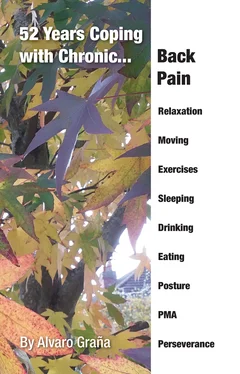– live life as normally as possible.
– keep up your daily activities avoiding heavy lifting/activity
– try to get fit by walking, swimming, or specific exercises (see Section PHYSICAL EXERCISES (page 58) on a regular basis.
– Stop any worries, and tensing up, to avoid feeling down or even depressed.
– Use relaxation techniques to avoid stress.(see RELAXATION page 149)
– Pace yourself - do a bit at a time, increasing your level of activity as time goes on. Monitor your activity to see clearly how you are coping. (see PACING – page 82).
– Be patient when looking for results and give yourself time.
– Be positive and realistic. A positive mind will give you a positive attitude, which will make you more active, able to resume normal activity giving you a sense of achievement and that all round feel-good effect, which will have a positive influence on your body. Remember not to over do it. (see POSITIVE MENTAL ATTITUDE – page 74)
– Stay as active as you can.
– Maintain general good health. (See GOOD GENERAL HEALTH (page 88).
THINGS TO AVOID
– Heavy lifting – lift what you can handle – always lift close to your body – bend your knees and no stooping, let your legs do the work for you – avoid twisting your back.
– Sitting in one position for a long time – use a support if necessary – use an upright chair – if after a while you feel stiff, get up and stretch.
– Standing still for a long time.
– Staying in bed for a long time, but if it is inevitable, try gentle stretching and joint movement excersises– stretch before going to sleep and before you get up in the morning.
– Feeling negative and disgruntled when you are in pain or experiencing low energy – tell yourself ‘this is only temporary’ and plan the next step for as soon as you are able to be active; this will give you something to focus on, keep you in a positive frame of mind and give you something to look forward to.
Personal experience – Due to a series of unexpected and unavoidable chain of events I was living with very high stress levels and realized this was detrimental to my condition. In my effort to bring my stress level down I was trying to live as normally as possible after concluding that, come what may, I am responsible for my own wellbeing. If I am in pain I have to be proactive and take action. I have to analise the scenario and work out why I am in pain. Is it something physical? Something I have done? Or is it something mental/psychological? Stress maybe? I began to notice that whenever I was in a lot of pain and exhausted, I was also feeling down, had negative thoughts, and was sometimes in a bad mood. I eventually realised that this was to do with my mental attitude and my reaction to pain...perhaps focusing too much on it. I decided I had to change my attitude.
PAIN SUFFERING SCENARIOS
There are at least three pain suffering scenarios pain sufferers might find themselves in:
Scenario 1- Suffering from pain and taking no action other than relying heavily on prescribed medication resulting in having no confidence.
Scenario 2- Suffering from pain and taking some action as well as taking prescribed medication. This action may involve trying complementary medicine in negligible quantities, too little to be of any benefit, expecting instant results and not giving it enough time to take effect.
Another action might be doing specific exercises to help with the pain, but in a controlled manner: pacing yourself, building it up slowly, and efficiently so that the muscles and ligaments do not get strained or damaged.
Maybe trying a different alternative treatment, once again not taking it very seriously, as lack of confidence brings doubt.
Scenario 3- Suffering from pain and taking positive action. Taking everything seriously, in a controlled manner, maximising efficiency. For instance deciding to take up complementary medicine, taking the recommended daily amounts on a regular basis. Deciding to try exercises and conscienciously following expert advice in a controlled manner, pacing yourself to maximise efficiency. Self discipline and persistence will result in reaching good fitness levels.
Analogy: One might be able to run around the block now and again in spite of not being fit, however a daily run of increasing length will result in fitness.
Looking into alternative solutions and staying positive will accomplish good results and boost confidence.
Personal experience - After a few years of trying really hard to live a normal life with the help of prescribed medication, remaining as active as I could by being pro-active in dealing with pain, and trying hard to have a positive attitude to chronic pain, I learnt various tips, such as pacing myself, avoiding lifting heavy things, not bending my back and avoiding stress among other things. I was still determined to find new solutions: I wanted to give up prescribed medication, so I went to see my GP (2003) who referred me to a Qualified Alternative Medicine Practitioner at University Hospital in Coventry. At that point I was suffering from joint pains everywhere, in addition to my usual pains to my lower back, neck and legs. Every morning I would wake up with pain in my joints (feet, ankles, knees, hips, elbows and hands). More on this later. So in summary, my condition has always been twofold: nerve pains in my spine from the back of my head down to my heels affecting two or more areas of my body, caused by inflammation to the nervous system. I sometimes experienced referred pains (inflammation) to my liver and other internal organs. This happens because nerves coming from the spine are connected to internal organs. I also suffered from severe migraines, sciatic pains in my leg (especially my right leg), and inflammation to the joints in my hip. When the inflammation affected my coxis, I found sitting very painful.
By this time I was slowly learning how to live with this condition which meant carrying various degrees of pain, being unable to move at times but still maintaining a positive attitude and a cool head to avoid depression.
CAUSES OF JOINT PAIN
Joint pain can be caused by many types of injuries or conditions. The following are some of the most common ones:
– Unusual exertion – A strain or sprain the ligaments or muscles can result from a sudden movement, improper movement or through overuse. In the case of back pain, discs can be damaged in the same way, and they can tear or overstretch.
– Injury, including fracture
– Osteoarthritis is the most common form of Arthritis. This chronic disease causes the cartilage between the bone joints to wear away, leading to stiffness and pain. OA, as it is known, involves growth of bone spurs and degeneration of cartilage at a joint (common in adults over the age of 45).
– Septic arthritis, which is the inflammation to a joint caused by bacterial invasion.
– Tendonitis, which is the inflammation, irritation and swelling of a tendon which is the fibrous structure that connects muscle to bone.
– Bursitis, which is inflammation to the bursa that lies between a tendon and skin or between a tendon and bone. The bursae are fluid filled sacs that cushion and pad bones allowing muscles and ligaments to move freely.
– Gout, which is specially found in the big toe.
– Infectious diseases can include the following:
– Influenza
– Measles
– Rheumatic fever
– Hepatitis
– Mumps
– Rubella (German Measles)
– Varicela (Chicken Pox)
– Osteomyelitis
– Auto immune diseases, such as rheumatoid arthritis and lupus.
Arthritis
Arthritis is inflammation of one or more joints, which results in pain, swelling and limited movement. Arthritis involves the breakdown of the cartilage which normally protects the joint, allowing for smooth movement. Cartilage also absorbs shock when pressure is placed on a joint while walking, running or jumping. Without the usual amount of cartilage, the bones rub together, causing pain, swelling (inflammation) and stiffness.
Читать дальше












